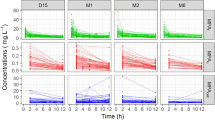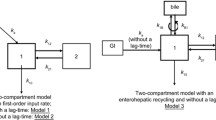Abstract
Background and Objectives
Renal function and the plasma albumin concentration have been shown to correlate with clearance of total mycophenolic acid (MPA). The hypothesis for the underlying mechanism is that low plasma albumin concentrations and accumulation of the glucuronide metabolite of MPA (MPAG) decrease the binding of MPA to albumin. The subsequent increase in the unbound fraction (fu) of MPA (MPAu) produces an increase in total MPA (MPAt) clearance. This study aimed to develop an empirical population pharmacokinetic model to describe the relationships between renal function and albumin concentration and MPAG, MPAu and MPAt, in order to provide insight into the mechanism by which renal function and plasma albumin affect the disposition of MPA.
Methods
774 MPAt, 479 MPAu and 772 total MPAG (MPAGt) plasma concentrations were available from 88 renal transplant recipients on days 11 and 140 after transplantation. Data were analysed using non-linear mixed-effects modelling.
Results
Time profiles of MPAu and MPAGt concentrations were adequately described by two 2-compartment pharmacokinetic models with a link between the central compartments, representing the glucuronidation of MPAu to form MPAG. MPAt concentrations were modelled using: [MPAt = [MPAu] + [MPAu] · θpb, with [MPAJ · θpb representing the bound MPA concentration, where [MPAt], [MPAu] and θpb represent MPAt concentration, MPAu concentration and a factor that correlates to the total number of protein binding places, respectively. According to this equation, fu= [MPAu]/[MPAt] = 1/(1 +θpb) · θpb, and therefore [MPAt], was significantly and independently correlated with Creatinine clearance (CLCR), the plasma albumin concentration and the MPAGt concentration (all p < 0.001). A reduction in CLCR from 60 to 25 mL/min correlated with an increase in fu from 2.7% to 3.5%, accumulation of MPAGt concentrations from 50 to 150 mg/L correlated with an increase in fu from 2.8% to 3.7%, and a decrease in plasma albumin concentration from 40 to 30g/L correlated with an increase in fu from 2.6% to 3.5%. No significant correlations were detected between MPAu clearance and the plasma albumin concentration or CLCR.
Conclusion
The model shows that low CLCR, low plasma albumin concentrations and high MPAG concentrations decrease MPAt exposure by affecting MPA binding to albumin.










Similar content being viewed by others
References
Kaufman DB, Shapiro R, Lucey MR, et al. Immunosuppression: practice and trends. Am J Transplant 2004; 4 Suppl. 9: 38–53
Bullingham RE, Nicholls AJ, Kamm BR. Clinical pharmacokinetics of mycophenolate mofetil. Clin Pharmacokinet 1998; 34: 429–55
Nowak I, Shaw LM. Mycophenolic acid binding to human serum albumin: characterization and relation to pharmacodynamics. Clin Chem 1995; 41: 1011–7
Shipkova M, Strassburg CP, Braun F, et al. Glucuronide and glucoside conjugation of mycophenolic acid by human liver, kidney and intestinal microsomes. Br J Pharmacol 2001; 132: 1027–34
Picard N, Ratanasavanh D, Premaud A, et al. Identification of the UDP-glucuronosyltransferase isoforms involved in mycophenolic acid phase II metabolism. Drug Metab Dispos 2005; 33: 139–46
Wilkinson GR, Shand DG. Commentary: a physiological approach to hepatic drug clearance. Clin Pharmacol Ther 1975; 18: 377–90
Van Hest RM, Mathot RA, Pescovitz MD, et al. Explaining variability in mycophenolic acid exposure to optimize mycophenolate mofetil dosing: a population pharmacokinetic meta-analysis of mycophenolic acid in renal transplant recipients. J Am Soc Nephrol 2006; 17: 871–80
Van Hest RM, Van Gelder T, Vulto AG, et al. Population pharmacokinetics of mycophenolic acid in renal transplant recipients. Clin Pharmacokinet 2005; 44: 1083–96
Shaw LM, Korecka M, Aradhye S, et al. Mycophenolic acid area under the curve values in African American and Caucasian renal transplant patients are comparable. J Clin Pharmacol 2000; 40: 624–33
Johnson AG, Rigby RJ, Taylor PJ, et al. The kinetics of mycophenolic acid and its glucuronide metabolite in adult kidney transplant recipients. Clin Pharmacol Ther 1999; 66: 492–500
Benet LZ, Hoener BA. Changes in plasma protein binding have little clinical relevance. Clin Pharmacol Ther 2002; 71: 115–21
Kaplan B, Meier-Kriesche HU, Friedman G, et al. The effect of renal insufficiency on mycophenolic acid protein binding. J Clin Pharmacol 1999; 39:715–20
Weber LT, Shipkova M, Lamersdorf T, et al. Pharmacokinetics of mycophenolic acid (MPA) and determinants of MPA free fraction in pediatric and adult renal transplant recipients. German Study group on Mycophenolate Mofetil Therapy in Pediatric Renal Transplant Recipients. J Am Soc Nephrol 1998; 9: 1511–20
Kuypers DR, Vanrenterghem Y, Squifflet JP, et al. Twelve-month evaluation of the clinical pharmacokinetics of total and free mycophenolic acid and its glucuronide metabolite in renal transplant recipients on low dose tacrolimus in combination with mycophenolate mofetil. Ther Drug Monit 2003; 25: 609–22
Shaw LM, Mick R, Nowak I, et al. Pharmacokinetics of mycophenolic acid in renal transplant recipients with delayed graft function. J Clin Pharmacol 1998; 38: 268–75
Van Gelder T, Hilbrands LB, Vanrenterghem Y, et al. A randomized double blind, multicenter plasma concentration study of the safety and efficacy of oral mycophenolate mofetil for the prevention of acute rejection after kidney transplantation. Transplantation 1999; 68: 261–6
Hale MD, Nicholls AJ, Bullingham RE, et al. The pharmacokinetic-pharmacodynamic relationship for mycophenolate mofetil in renal transplantation. Clin Pharmacol Ther 1998; 64: 672–83
Tsina I, Chu F, Hama K, et al. Manual and automated (robotic) high-performance liquid chromatography methods for the determination of mycophenolic acid and its glucuronide conjugate in human plasma. J Chrom B Biomed Appl 1996; 675: 119–29
Karlsson MO, Sheiner LB. The importance of modeling interoccasion variabililty in population pharmacokinetic analyses. J Pharmacokinet Biopharm 1993;21:735–50
Henningsson A, Sparreboom A, Sandström M, et al. Population pharmacokinetic modelling of unbound and total plasma concentrations of paclitaxel in cancer patients. Eur J Cancer 2003; 39: 1105–14
Sheiner LB, Beal SL. Evaluation of methods for estimating population pharmacokinetic parameters: III. Monoexponential model: routine clinical pharmacokinetic data. J Pharmacokinet Biopharm 1983; 11: 303–19
Cockcroft DW, Gault MH. Prediction of Creatinine clearance from serum Creatinine. Nephron 1976; 16: 31–41
Mandema JW, Verotta D, Sheiner LB. Building population pharmacokineticpharmacodynamic models: I. Models for covariate effects. J Pharmacokinet Biopharm 1992; 20: 511–28
Beal SL, Sheiner LB, NONMEM Project Group. NONMEM user’ guides. San Fransisco (CA): University of California at San Fransisco, 1998
Ette E, Ludden T. Population pharmacokinetic modeling: the importance of informative graphics. Pharm Res 1995; 12: 1845–55
Jadhav PR, Gobburu JV. A new equivalence based metric for predictive check to qualify mixed-effects models. AAPS J 2005; 7 (3): E523–31
Hesselink DA, Van Hest RM, Mathot RA, et al. Cyclosporine interacts with mycophenolic acid by inhibiting the multidrug resistance-associated protein 2. Am J Transplant 2005; 5: 987–94
Van Gelder T, Klupp J, Barten MJ, et al. Comparison of the effects of tacrolimus and cyclosporine on the pharmacokinetics of mycophenolic acid. Ther Drug Monit 2001; 23: 119–28
Weber LT, Lamersdorf T, Shipkova M, et al. Area under the plasma concentration time curve for total, but not for free, mycophenolic acid increases in the stable phase after renal transplantation: a longitudinal study in pediatric patients. German Study Group on Mycophenolate Mofetil Therapy in Pediatric Renal Transplant Recipients. Ther Drug Monit 1999; 21: 498–506
Kaplan B, Gruber SA, Nallamathou R, et al. Decreased protein binding of mycophenolic acid associated with leukopenia in a pancreas transplant recipient with renal failure. Transplantation 1998; 65: 1127–9
Mudge DW, Atcheson BA, Taylor PJ, et al. Severe toxicity associated with a markedly elevated mycophenolic acid free fraction in a renal transplant recipient. Ther Drug Monit 2004; 26: 453–5
Weber LT, Shipkova M, Armstrong VW, et al. The pharmacokineticpharmacodynamic relationship for total and free mycophenolic acid in pediatric renal transplant recipients: a report from the German study group on mycophenolate mofetil therapy. J Am Soc Nephrol 2002; 13: 759–68
Atcheson BA, Taylor PJ, Mudge DW, et al. Mycophenolic acid pharmacokinetics and related outcomes early after renal transplant. Br J Clin Pharmacol 2005; 59: 271–80
Atcheson BA, Taylor PJ, Kirkpatrick CM, et al. Free mycophenolic acid should be monitored in renal transplant recipients with hypoalbuminemia. Ther Drug Monit 2004; 26: 284–6
Kiberd BA, Lawen J, Fraser AD, et al. Early adequate mycophenolic acid exposure is asociated with less rejection in kidney transplantation. Am J Transplant 2004; 4: 1079–83
Higaki K, Yamashita S, Amidon GL. Time-dependent oral absorption models. J Pharmacokin Pharmacodyn 2001; 28: 109–28
Acknowledgements
The authors are very grateful for the contributions of Dr I Nowak to MPA unbound fraction measurement and Dr M Korecka to sample stability analyses. No sources of funding were used to assist in the preparation of this study. The authors have no conflicts of interest that are directly relevant to the content of this study.
Author information
Authors and Affiliations
Corresponding author
Rights and permissions
About this article
Cite this article
van Hest, R.M., van Gelder, T., Vulto, A.G. et al. Pharmacokinetic Modelling of the Plasma Protein Binding of Mycophenolic Acid in Renal Transplant Recipients. Clin Pharmacokinet 48, 463–476 (2009). https://doi.org/10.2165/11312600-000000000-00000
Published:
Issue Date:
DOI: https://doi.org/10.2165/11312600-000000000-00000




